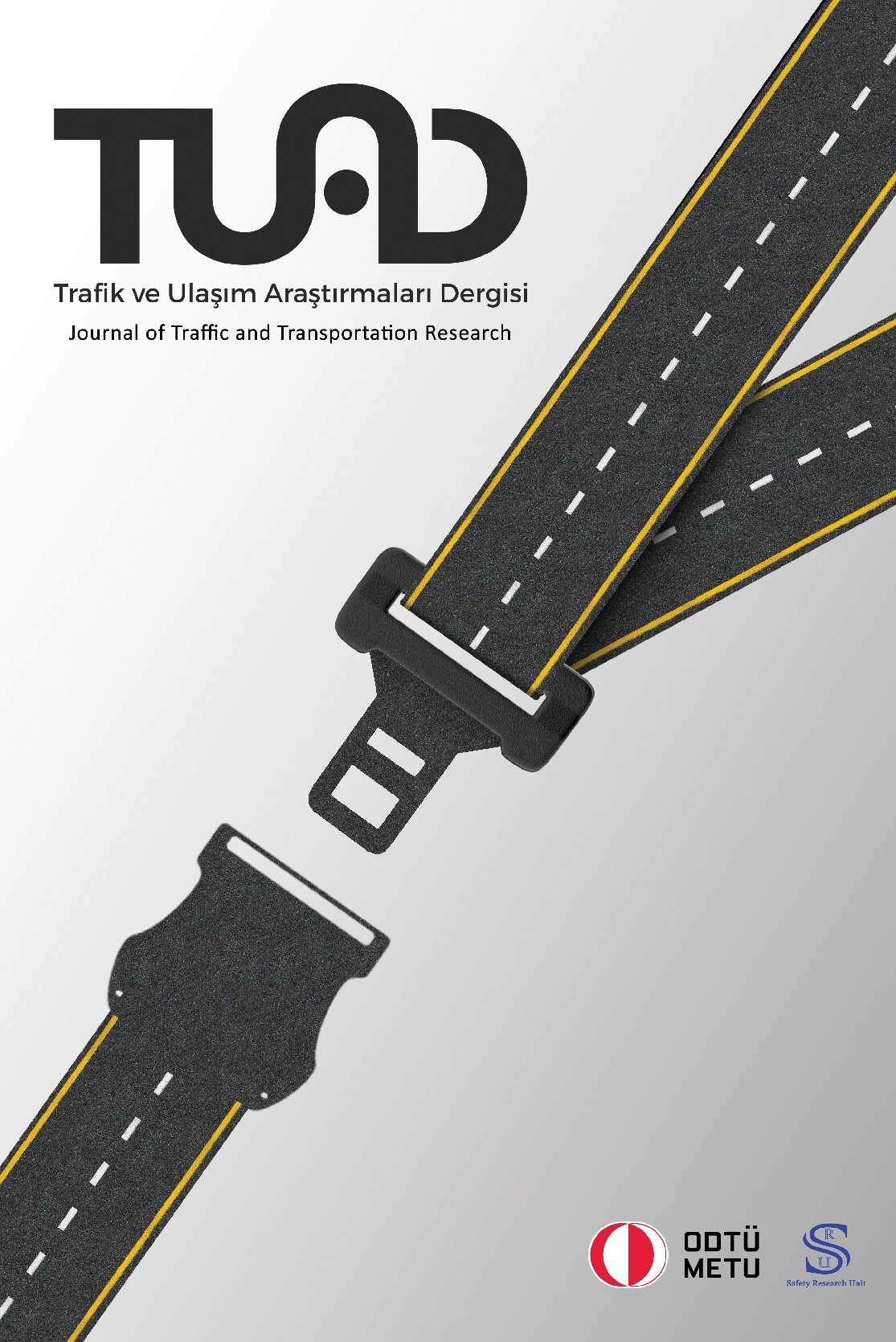Özgeci Bir Perspektiften Otostopa Yönelik Tutumların İncelenmesi
Examining Attitudes Towards Hitchhiking from an Altruistic Perspective
hitchhiking, hitchhiker, altruism,
___
- Batson, C. D., Duncan, B. D., Ackerman, P., Buckley, T. ve Birch, K. (1981). Is empathic emotion a source of altruistic motivation?. Journal of Personality and Social Psychology, 40(2), 290-302. doi:10.1037/0022-3514.40.2.290.
- Buss, D. (2015). Evolutionary psychology: The new science of the mind. United Kingdom: Taylor & Francis.
- Campbell, M. D. (1974). A controlled investigation of altruistic behavior: Helping the hitchhiker. Proceedings of the Division of Personality and Society Psychology, 1(1), 174-176. doi:10.1177/014616727400100160.
- Eby, D. W. (2000). How often do people use safety belts in your community? A step-by-step guide for assessing community safety belt use. 18 Nisan 2020 tarihinde https://deepblue.lib.umich.edu/bitstream/handle/2027.42/1322/94063.0001.001.pdf?sequence=2 adresinden alınmıştır.
- Eby, D. W. (2011). Naturalistic observational field techniques for traffic psychology research. B.E. Porter (Ed.) Handbook of Traffic Psychology içinde (s. 61-72). USA: Acedemic Press.
- Franzoi, S. L. (1985). Personality characteristics of the cross-country hitchhiker. Adolescence, 20(79), 655-668.
- Glick, P. ve Fiske, S. T. (1996). The ambivalent sexism inventory: Differentiating hostile and benevolent sexism. Journal of Personality and Social Psychology, 70(3), 491–512. doi:10.1037/0022-3514.70.3.491.
- Guéguen, N. (2007). Bust size and hitchhiking: A field study. Perceptual and Motor Skills, 105(3), 1294-1298. doi:10.2466/pms.105.4.1294-1298.
- Guéguen. N. ve Lamy L. (2009). Hitchhiking Women’s Hair Color. Perceptual and Motor Skills, 109, 941-948. doi:10.2466/pms.109.3.941-948.
- Guéguen, N., Meineri, S. ve Stefan, J. (2012). " Say it with Flowers"... to Female Drivers: Hitchhikers Holding Flowers and Driver Behavior. North American Journal of Psychology, 14(3), 623-628.
- Guéguen, N. ve Stefan, J. (2013). Hitchhiking and the ‘Sunshine Driver’: Further Effects of Weather Conditions on Helping Behavior. Psychological Reports, 113(3), 994-1000. doi:10.2466/17.07.PR0.113x30z8.
- Johnson, R. J., McCaul, K. D. ve Klein, W. M. (2002). Risk involvement and risk perception among adolescents and young adults. Journal of Behavioral Medicine, 25(1), 67-82.
- Kabahatler Kanunu (30 Mart 2005). 16 Nisan 2020 tarihinde https://www.mevzuat.gov.tr/MevzuatMetin/1.5.5326.pdf adresinden alınmıştır.
- Kablan, M. (2019). ODTU 101: Ulaşım. 16 Nisan 2020 tarihinde http://www.yazhocam.com/kampus/odtu101-ulasim/ adresinden alınmıştır.
- Morgan, C. J., Lockard, J. S., Fahrenbruch, C. E. ve Smith, J. L. (1975). Hitchhiking: Social signals at a distance. Bulletin of the Psychonomic Society, 5(6), 459-461.
- Oda, R., Okuda, A., Takeda, M. ve Hiraishi, K. (2014). Provision or good genes? Menstrual cycle shifts in women's preferences for short-term and long-term mates' altruistic behavior. Evolutionary Psychology, 12(5), 888-900. doi:10.1177/147470491401200503.
- Otostop. (t.y.). Türk Dil Kurumu Türkçe Sözlük içinde 10 Mart 2020 tarihinde https://sozluk.gov.tr/?kelime=otostop%20 adresinden alınmıştır.
- Pazhoohi, F. ve Burriss, R. P. (2016). Hijab and “hitchhiking”: A field study. Evolutionary Psychological Science, 2(1), 32-37. doi:10.1007/s40806-015-0033-5.
- Rushton, J. P., Chrisjohn, R. D. ve Fekken, G. C. (1981). The altruistic personality and the self-report altruism scale. Personality and Individual Differences, 2(4), 293-302. doi:10.1016/0191-8869(81)90084-2.
- Snyder, M., Grather, J. ve Keller, K. (1974). Staring and compliance: A field experiment on hitchhiking. Journal of Applied Social Psychology, 4(2), 165-170, doi:10.1111/j.1559-1816.1974.tb00666.x.
- Sioui, L., Morency, C. ve Trépanier, M. (2013). How carsharing affects the travel behavior of households: A case study of Montréal, Canada. International Journal of Sustainable Transportation, 7(1), 52-69. doi:10.1080/15568318.2012.660109
- Tekeş, B. ve Hasta, D. (2015). Özgecilik ölçeği: Geçerlik ve güvenirlik çalışması. Nesne Psikoloji Dergisi, 3(6), 55-75.
- Tekeş, B. (2013). Engellilere yönelik önyargıyı yordayan değişkenler: Kültürler arası bir araştırma (Yayımlanmamış yüksek lisans tezi). Ankara Üniversitesi, Ankara.
- Trivers, R. L. (1971). The evolution of reciprocal altruism. The Quarterly Review of Biology, 46(1), 35-57. doi:10.1086/406755.
- Xu, F., Morgan, M. ve Song, P. (2009). Students' travel behaviour: a cross‐cultural comparison of UK and China. International Journal of Tourism Research, 11(3), 255-268. doi:10.1002/jtr.686.
- ISSN: 2667-8071
- Yayın Aralığı: Yılda 2 Sayı
- Başlangıç: 2018
- Yayıncı: Türker ÖZKAN
Trafik Kazalarından Sonra Çocuklarda Görülen Psikososyal Etkiler ve Tedavi Yaklaşımları
Özgeci Bir Perspektiften Otostopa Yönelik Tutumların İncelenmesi
Ulusal Seviyede Kültür ve Trafik Ölüm Oranları İlişkisi: Ekonominin Düzenleyici Rolü
Yeşim ÜZÜMCÜOĞLU ZİHNİ, Gaye SOLMAZER, Türker ÖZKAN
Yol Verme Davranışı: Sürücülerin Yol Verme Davranışını Anlamak Üzerine Karma Yöntemli Bir Çalışma
Ece Naz DEMİR, Hafize Berin DÖNMEZ, Mehmet ÖZDEN, Nursima ÜNVER, Gizem FINDIK, Bahar ÖZ
Genç Sürücülerde Öfke Deneyimleri: Bir Nitel Analiz Çalışması
